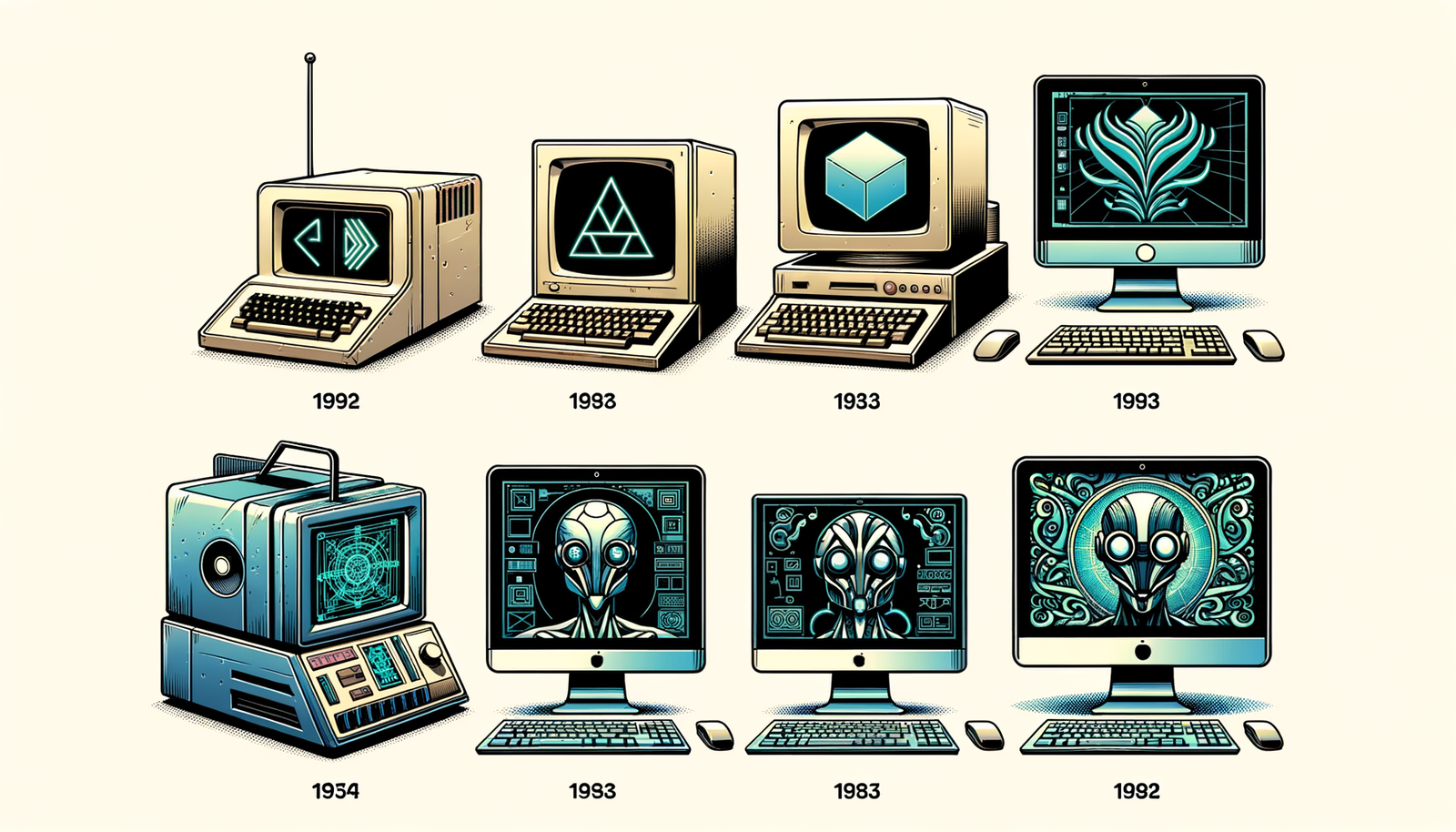Your Cart is Empty
Customer Testimonials
-
"Great customer service. The folks at Novedge were super helpful in navigating a somewhat complicated order including software upgrades and serial numbers in various stages of inactivity. They were friendly and helpful throughout the process.."
Ruben Ruckmark
"Quick & very helpful. We have been using Novedge for years and are very happy with their quick service when we need to make a purchase and excellent support resolving any issues."
Will Woodson
"Scott is the best. He reminds me about subscriptions dates, guides me in the correct direction for updates. He always responds promptly to me. He is literally the reason I continue to work with Novedge and will do so in the future."
Edward Mchugh
"Calvin Lok is “the man”. After my purchase of Sketchup 2021, he called me and provided step-by-step instructions to ease me through difficulties I was having with the setup of my new software."
Mike Borzage
Design Software History: The Evolution of Design Software: From Early CAD to AI-Driven Innovation
November 20, 2024 5 min read


Introduction
Design software has become an indispensable tool across a myriad of industries, fundamentally transforming the way products are conceptualized, developed, and brought to market. From architecture and engineering to automotive and aerospace, these powerful applications have enabled professionals to push the boundaries of innovation. The significance of design software lies not only in its ability to streamline complex processes but also in its capacity to foster creativity and collaboration on a global scale. Since the late 20th century, technological advancements have accelerated the evolution of design software, introducing sophisticated features that have revolutionized traditional design methodologies. Understanding the historical context of these developments is crucial to appreciating the current state of design software and anticipating future innovations that will continue to shape various sectors.
Historical Milestones in Design Software Development
The journey of design software began with the advent of Computer-Aided Design (CAD) systems, which marked a significant departure from manual drafting techniques. In the early days, CAD systems primarily facilitated 2D drafting, allowing designers to create precise technical drawings with increased efficiency. The transition from 2D to 3D modeling represented a pivotal innovation, enabling the visualization of objects in three dimensions and fostering a deeper understanding of spatial relationships. This evolution was propelled by the development of geometric modeling and solid modeling technologies, which provided the mathematical foundations necessary for representing complex shapes and structures.
Among the influential software developments that have shaped the landscape is AutoCAD, introduced by Autodesk in 1982. AutoCAD democratized access to CAD tools, making them available on personal computers and revolutionizing industries such as architecture and engineering. SolidWorks, launched in 1995 by SolidWorks Corporation, brought parametric, feature-based modeling to a wider audience, emphasizing ease of use and affordability. Similarly, CATIA (Computer Aided Three-dimensional Interactive Application), developed by Dassault Systèmes, became a critical tool in the aerospace and automotive industries due to its advanced capabilities in surface modeling and product lifecycle management.
Notable figures have also played instrumental roles in the evolution of design software. Ivan Sutherland is often regarded as the father of computer graphics due to his creation of Sketchpad in 1963. Sketchpad was the first program to utilize a graphical user interface for interacting with a computer, laying the groundwork for future CAD systems. Companies like Autodesk and PTC (Parametric Technology Corporation) significantly contributed to advancing architectural and engineering design. PTC's introduction of Pro/ENGINEER in 1988 was groundbreaking, as it was one of the first to incorporate parametric and feature-based modeling, which allowed for more dynamic and flexible design processes.
Core Technologies and Mathematical Models
The sophistication of modern design software is anchored in complex mathematical models and algorithms that enable precise and efficient creation of digital representations. At the core is parametric design, a paradigm that uses parameters and constraints to define shapes and geometry. This approach allows designers to easily modify dimensions and relationships, leading to more iterative and flexible workflows. Non-Uniform Rational B-Splines (NURBS) are another fundamental component, providing a mathematical method for representing curves and surfaces with great accuracy. NURBS are essential for modeling organic shapes and intricate geometries commonly found in industries like automotive and aerospace design.
Geometric modeling kernels, such as ACIS and Parasolid, serve as the computational engines behind many CAD applications. They handle the complex calculations required for solid modeling operations, including Boolean operations, filleting, and shelling. The role of algorithms extends beyond modeling to include rendering and simulation techniques. Advanced rendering algorithms enable photorealistic visualization of designs, allowing for virtual prototyping and presentation. Simulation algorithms, on the other hand, facilitate analysis of stresses, fluid dynamics, and other physical behaviors, empowering engineers to optimize designs before physical testing.
The impact of these technologies on design processes is profound. Advancements in mathematical modeling have enabled the creation of more complex and efficient design solutions. Designers can now explore a wider range of possibilities and iterate rapidly, reducing time to market and improving product quality. For example, the integration of simulation tools within design software allows for the assessment of performance and feasibility during the early stages of development. This integration leads to a more holistic design approach, where multiple disciplines can collaborate seamlessly within a unified environment.
- Parametric design allows for dynamic adjustments and real-time updates to models.
- NURBS provide the flexibility to represent both standard geometric shapes and free-form organic structures.
Future Directions and Trends in Design Software
The next generation of design software is poised to be shaped by emerging technologies that promise to further revolutionize the industry. The integration of Artificial Intelligence (AI) and Machine Learning (ML) is at the forefront, offering the potential to automate routine tasks and provide predictive insights. AI can assist in generating design alternatives based on specified criteria, while ML algorithms can learn from vast datasets to improve efficiency and accuracy. The adoption of cloud computing is also significant, enabling collaborative work environments where teams can access and edit designs in real-time from anywhere in the world.
The growth of additive manufacturing, commonly known as 3D printing, has substantial software implications. Design software must now accommodate the creation of models suitable for additive processes, which often involve complex internal structures and require considerations for material properties and printability. This shift necessitates tools that can handle generative design and topology optimization, allowing for the development of lightweight yet strong components that were previously unattainable through traditional manufacturing methods.
The evolution of user interface design and user experience in software applications continues to be a critical factor. As software becomes more powerful, it also needs to remain accessible to users with varying levels of expertise. Intuitive interfaces, customizable workflows, and immersive technologies such as virtual and augmented reality are enhancing the way designers interact with their tools. Predictions indicate a trend towards greater collaboration, with platforms that support simultaneous multi-user editing and communication. Accessibility and inclusivity are also becoming priorities, ensuring that design software supports diverse user needs and contributes to broadening participation in design fields.
- AI and ML can optimize designs for performance and cost simultaneously.
- Cloud-based platforms facilitate global collaboration and data sharing.
Conclusion
The evolution of design software from simple 2D drafting tools to sophisticated platforms integrating AI and cloud capabilities has had a transformative impact across industries. This progression has not only enhanced efficiency and precision but has also expanded the horizons of what is possible in design and engineering. The ongoing innovation within this space is crucial for addressing emerging challenges and leveraging new opportunities presented by technological advancements. It is essential for professionals and enthusiasts alike to engage with both the historical and contemporary developments in design software. Such engagement fosters a deeper understanding of the tools at our disposal and inspires the next wave of innovations that will continue to shape the future of design.
Also in Design News

Cinema 4D Tip: Lock Framing Early with Cinema 4D Safe Frames and Aspect Overlays
October 30, 2025 2 min read
Read More
ZBrush Tip: Conservative Projection Workflow for Artifact-Free Detail Transfer
October 30, 2025 2 min read
Read More
V-Ray Tip: Bake Static GI into Lightmaps for Real-Time Engines
October 30, 2025 2 min read
Read MoreSubscribe
Sign up to get the latest on sales, new releases and more …


